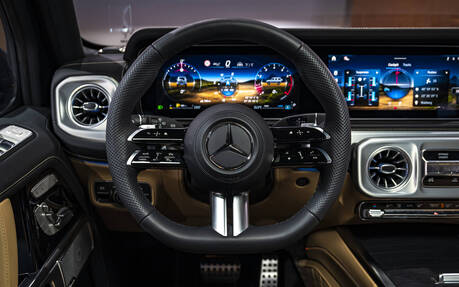2025 Mercedes-Benz G 550 and G 63 Get Key Changes, Electric G Coming Soon
Boxy, loud, luxurious and totally indifferent to the laws of physics, the Mercedes-Benz G-Class gets light updates for 2025 in its gasoline-powered variations. These changes include a new engine, exterior iterations and a redesigned interior. And let's not forget the new all-electric variant of the G-Class, due to arrive later in April.
The Car Guide flew to Graz, Austria, to learn more about the 2025 evolution of this G-Class, which is built on the same body-on-frame chassis since 1979, and has kept (almost) all of its beloved boxiness along the way.
- Also: 2025 Mercedes-Benz G 580 Goes Electric With EQ Technology
- Also: First Drive: 2025 Mercedes-Benz G 550, G 63 And All-New Electric G 580
The G 550 Goes From Eight to Six Cylinders
The exterior changes to the G-Class’s "entry-level" model, the 550, are so discreet that they are hard to notice at first glance. At the front, it gets a new grille with four horizontal slats and a slightly modified lower bumper. On the sides, the A-pillars have been rounded off to contribute to aerodynamics. At the very top of the windshield, a new rounded deflector performs similar functions. The G 550 swaps its 4.0-litre V8 engine for a twin-turbocharged inline-six with mild hybrid tech that churns out 443 horsepower and 413 lb-ft of torque. That’s 37 lb-ft less torque, but 27 more horsepower than the outgoing V8.

The G 550 is equipped with locking differentials, as well as the ability to tilt 35 degrees sideways and wade through 700 mm of water.
Inside, the cabin has been given a slight remodel, with add-ons that include new heated and cooled cupholders and the latest iteration of Mercedes-Benz's MBUX infotainment system, which adds a pair of screens for the second row.

The G 63 Gets a Mild Hybrid System and a Trick Suspension
The unbridled G 63 gets much the same physical iterations as its little brother the G 550, but sports the AMG vertical slat grille. This year, Mercede-Benz also offers G 550 and G 63 owners a more comprehensive choice of exterior colours and options through its MANUFAKTUR personalization arm.
Its hand-built twin-turbocharged 4.0-litre V8 remains under the hood, but it has been given a mild hybrid system. While its performance ratings stay the same, at 577 hp and 627 lb-ft of torque, Mercedes claims that the G 63 can now sprint from 0 to 97 km/h in 4.2 seconds, compared with 4.5 seconds for the outgoing model.

The G 63's most important new feature is undoubtedly the optional AMG Active Ride Control suspension. This technology is already fitted to the sporty AMG GT and includes a hydraulic component that controls the adaptive dampers in real time. According to the manufacturer, this enables the G 63 to benefit from a better balance between off-road performance and comfort during everyday driving. This happened thanks to the suspension's ability to deploy maximum responsiveness at all four corners independently.
The interior of the G 63 benefits from the same redesign as its little brother, the G 550. However, the MBUX infotainment system receives new AMG-specific features, including a "transparent hood" function that broadcasts images from the lower front camera so the driver can better anticipate obstacles ahead.

A Tiny Bit of Canadian Blood!
Finally, it's important to point out that the famous G is not assembled in a conventional Mercedes-Benz factory. Instead, G-Class models are built at a site owned and operated by Graz-based subcontractor Magna Steyr. This site has assembled specialty vehicles like 1971 Pinzgauer, along with more mainstream Euro-market U.S. cars like the Jeep Grand Cherokee, and it is now the birthplace of the BMW Z4/Toyota Supra combo. Magna Styr is also a subsidiary of Canadian company Magna International, based in Aurora, Ontario.
The Car Guide will have the opportunity to hear the G 550's new engine roar, try out the G 63's new suspension, and even put the new electric G-Wagen through its paces next month. Stay tuned!
